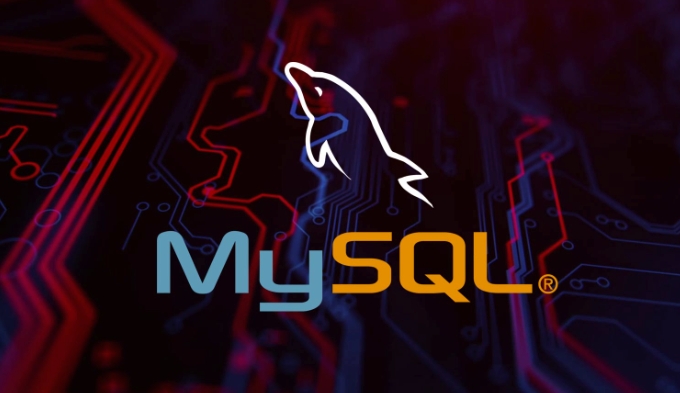Securing MySQL Backups with Encryption and Access Control
MySQL backup security needs to be guaranteed through encryption and access control. 1. Use MySQL's own tools such as mysqlbackup or with openssl to achieve backup encryption; 2. Restrict backup execution and access rights through operating system permission management, set special directories and users, and disable unnecessary login and execution rights; 3. Securely transfer and store backup files, use encryption protocols to transmit, enable cloud storage encryption, avoid sharing unencrypted data, and clean old backups regularly. Only by combining encryption, access control and process management can we comprehensively improve security.

The security of MySQL backups is often easily overlooked, but the consequences can be serious if data is breached or lost. Encryption and access control are two key means of protecting backup files. From the perspective of actual operation, we will explain how to do it in several key parts.

1. Use MySQL's own tools to encrypt and backup
MySQL provides a variety of backup methods, among which both mysqldump and mysqlbackup support encryption options. If you are using the commercial version of MySQL Enterprise Backup (MEB), you can directly add parameters to the command to encrypt the backup:
mysqlbackup --backup-image=backup.enc --encrypt --key-file=my_key.key backup-to-image
This command will package the entire backup into an encrypted file, and the key file is also required to be used when decrypting. For open source versions, although there is no built-in encryption, it can be implemented with system-level tools such as gpg or openssl :

mysqldump mydb | openssl aes-256-cbc -salt > backup.sql.enc
Even if the backup file generated in this way is obtained by others, the content cannot be read directly.
2. Control who can perform backups and access backup files
Permission management is not just a matter at the database level, but also an operating system-level access control is important. Ensure that only necessary users can run backup scripts, read and write backup directories.

- Put backup scripts and files in a dedicated directory, such as
/var/backups/mysql/ - Set directory permissions to
700, and belong to specific users, such asmysql_backup - Assign the minimum permission to this user, it is safer not to give shell login permissions
You can also configure sudoers to allow the application or monitoring service to call backup commands in a restricted manner instead of directly opening up root permissions.
3. Safely store and transfer backup files
If the backup file itself is saved in a location accessible to the public network, or is transmitted through a plaintext protocol, it is very risky. suggestion:
- Use SFTP or rsync over SSH instead of FTP to transfer backups
- If you want to upload to cloud storage, enable object encryption (such as SSE for AWS S3)
- Do not place unencrypted backups in code repositories or shared network disks
Also, be careful to clean old backups regularly. Some companies deleted the key by mistake but retained the plain text backup, which became a security risk.
Basically that's it. Encryption is not omnipotent, and access control cannot be relied on alone. Only by combining the two and doing a good job of permission division and life cycle management in the process can the security of MySQL backup be truly improved.
The above is the detailed content of Securing MySQL Backups with Encryption and Access Control. For more information, please follow other related articles on the PHP Chinese website!

Hot AI Tools

Undress AI Tool
Undress images for free

Undresser.AI Undress
AI-powered app for creating realistic nude photos

AI Clothes Remover
Online AI tool for removing clothes from photos.

Clothoff.io
AI clothes remover

Video Face Swap
Swap faces in any video effortlessly with our completely free AI face swap tool!

Hot Article

Hot Tools

Notepad++7.3.1
Easy-to-use and free code editor

SublimeText3 Chinese version
Chinese version, very easy to use

Zend Studio 13.0.1
Powerful PHP integrated development environment

Dreamweaver CS6
Visual web development tools

SublimeText3 Mac version
God-level code editing software (SublimeText3)
 Using Common Table Expressions (CTEs) in MySQL 8
Jul 12, 2025 am 02:23 AM
Using Common Table Expressions (CTEs) in MySQL 8
Jul 12, 2025 am 02:23 AM
CTEs are a feature introduced by MySQL8.0 to improve the readability and maintenance of complex queries. 1. CTE is a temporary result set, which is only valid in the current query, has a clear structure, and supports duplicate references; 2. Compared with subqueries, CTE is more readable, reusable and supports recursion; 3. Recursive CTE can process hierarchical data, such as organizational structure, which needs to include initial query and recursion parts; 4. Use suggestions include avoiding abuse, naming specifications, paying attention to performance and debugging methods.
 Strategies for MySQL Query Performance Optimization
Jul 13, 2025 am 01:45 AM
Strategies for MySQL Query Performance Optimization
Jul 13, 2025 am 01:45 AM
MySQL query performance optimization needs to start from the core points, including rational use of indexes, optimization of SQL statements, table structure design and partitioning strategies, and utilization of cache and monitoring tools. 1. Use indexes reasonably: Create indexes on commonly used query fields, avoid full table scanning, pay attention to the combined index order, do not add indexes in low selective fields, and avoid redundant indexes. 2. Optimize SQL queries: Avoid SELECT*, do not use functions in WHERE, reduce subquery nesting, and optimize paging query methods. 3. Table structure design and partitioning: select paradigm or anti-paradigm according to read and write scenarios, select appropriate field types, clean data regularly, and consider horizontal tables to divide tables or partition by time. 4. Utilize cache and monitoring: Use Redis cache to reduce database pressure and enable slow query
 Optimizing complex JOIN operations in MySQL
Jul 09, 2025 am 01:26 AM
Optimizing complex JOIN operations in MySQL
Jul 09, 2025 am 01:26 AM
TooptimizecomplexJOINoperationsinMySQL,followfourkeysteps:1)EnsureproperindexingonbothsidesofJOINcolumns,especiallyusingcompositeindexesformulti-columnjoinsandavoidinglargeVARCHARindexes;2)ReducedataearlybyfilteringwithWHEREclausesandlimitingselected
 Analyzing Query Execution with MySQL EXPLAIN
Jul 12, 2025 am 02:07 AM
Analyzing Query Execution with MySQL EXPLAIN
Jul 12, 2025 am 02:07 AM
MySQL's EXPLAIN is a tool used to analyze query execution plans. You can view the execution process by adding EXPLAIN before the SELECT query. 1. The main fields include id, select_type, table, type, key, Extra, etc.; 2. Efficient query needs to pay attention to type (such as const, eq_ref is the best), key (whether to use the appropriate index) and Extra (avoid Usingfilesort and Usingtemporary); 3. Common optimization suggestions: avoid using functions or blurring the leading wildcards for fields, ensure the consistent field types, reasonably set the connection field index, optimize sorting and grouping operations to improve performance and reduce capital
 Best Practices for Securing Remote Access to MySQL
Jul 12, 2025 am 02:25 AM
Best Practices for Securing Remote Access to MySQL
Jul 12, 2025 am 02:25 AM
The security of remote access to MySQL can be guaranteed by restricting permissions, encrypting communications, and regular audits. 1. Set a strong password and enable SSL encryption. Force-ssl-mode=REQUIRED when connecting to the client; 2. Restrict access to IP and user rights, create a dedicated account and grant the minimum necessary permissions, and disable root remote login; 3. Configure firewall rules, close unnecessary ports, and use springboard machines or SSH tunnels to enhance access control; 4. Enable logging and regularly audit connection behavior, use monitoring tools to detect abnormal activities in a timely manner to ensure database security.
 how to connect excel to mysql database
Jul 16, 2025 am 02:52 AM
how to connect excel to mysql database
Jul 16, 2025 am 02:52 AM
There are three ways to connect Excel to MySQL database: 1. Use PowerQuery: After installing the MySQLODBC driver, establish connections and import data through Excel's built-in PowerQuery function, and support timed refresh; 2. Use MySQLforExcel plug-in: The official plug-in provides a friendly interface, supports two-way synchronization and table import back to MySQL, and pay attention to version compatibility; 3. Use VBA ADO programming: suitable for advanced users, and achieve flexible connections and queries by writing macro code. Choose the appropriate method according to your needs and technical level. PowerQuery or MySQLforExcel is recommended for daily use, and VBA is better for automated processing.
 mysql common table expression (cte) example
Jul 14, 2025 am 02:28 AM
mysql common table expression (cte) example
Jul 14, 2025 am 02:28 AM
CTE is a temporary result set in MySQL used to simplify complex queries. It can be referenced multiple times in the current query, improving code readability and maintenance. For example, when looking for the latest orders for each user in the orders table, you can first obtain the latest order date for each user through the CTE, and then associate it with the original table to obtain the complete record. Compared with subqueries, the CTE structure is clearer and the logic is easier to debug. Usage tips include explicit alias, concatenating multiple CTEs, and processing tree data with recursive CTEs. Mastering CTE can make SQL more elegant and efficient.
 Securing MySQL Connections with SSL/TLS Encryption
Jul 21, 2025 am 02:08 AM
Securing MySQL Connections with SSL/TLS Encryption
Jul 21, 2025 am 02:08 AM
Why do I need SSL/TLS encryption MySQL connection? Because unencrypted connections may cause sensitive data to be intercepted, enabling SSL/TLS can prevent man-in-the-middle attacks and meet compliance requirements; 2. How to configure SSL/TLS for MySQL? You need to generate a certificate and a private key, modify the configuration file to specify the ssl-ca, ssl-cert and ssl-key paths and restart the service; 3. How to force SSL when the client connects? Implemented by specifying REQUIRESSL or REQUIREX509 when creating a user; 4. Details that are easily overlooked in SSL configuration include certificate path permissions, certificate expiration issues, and client configuration requirements.







